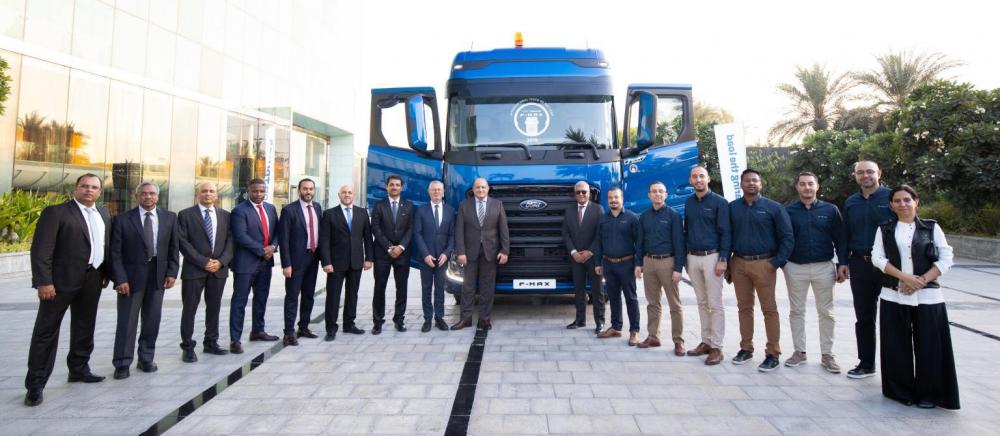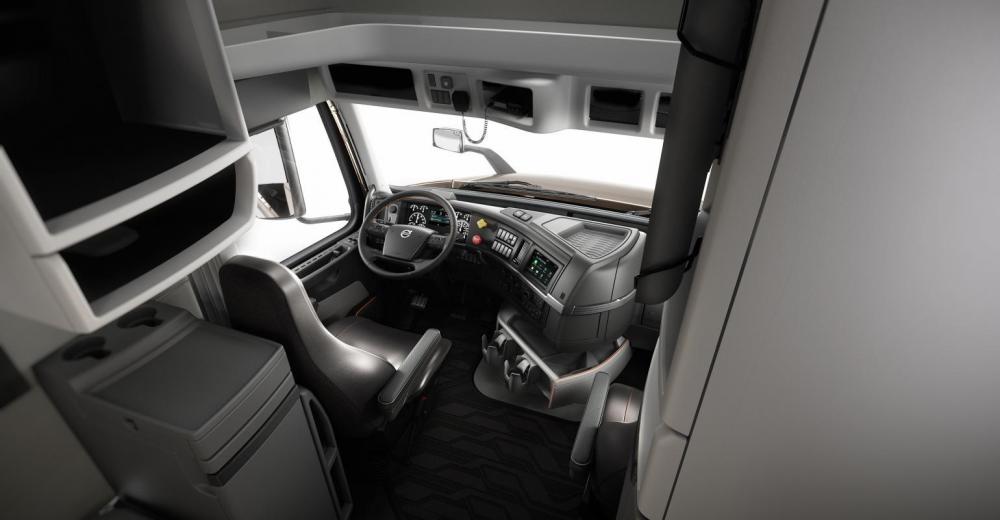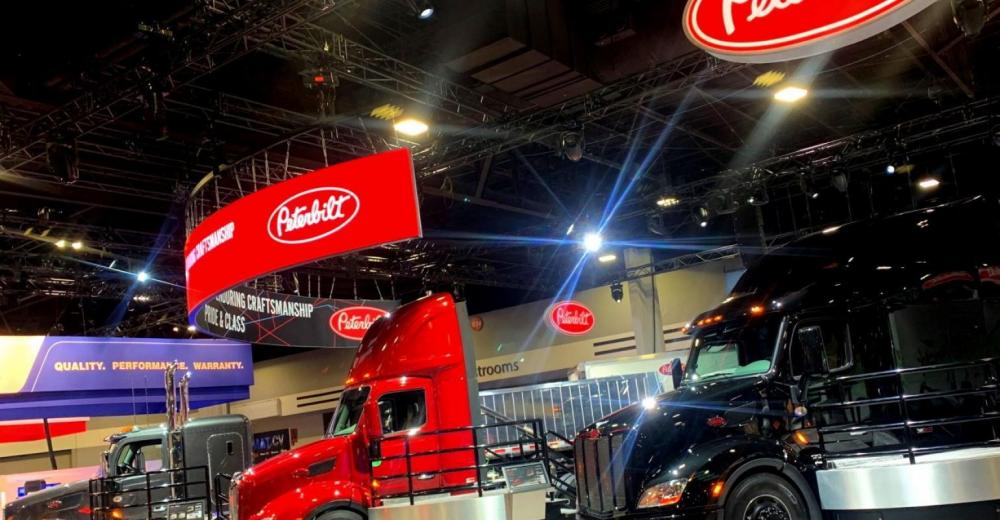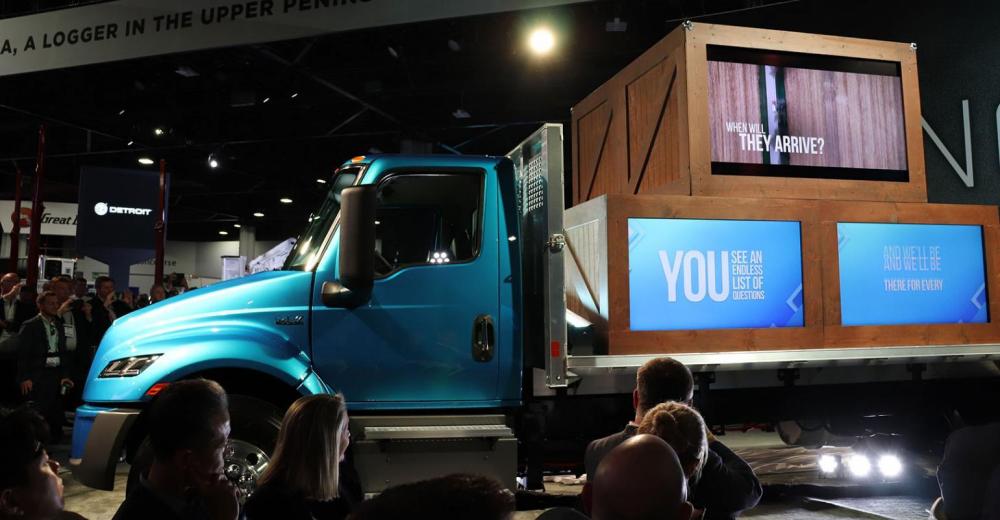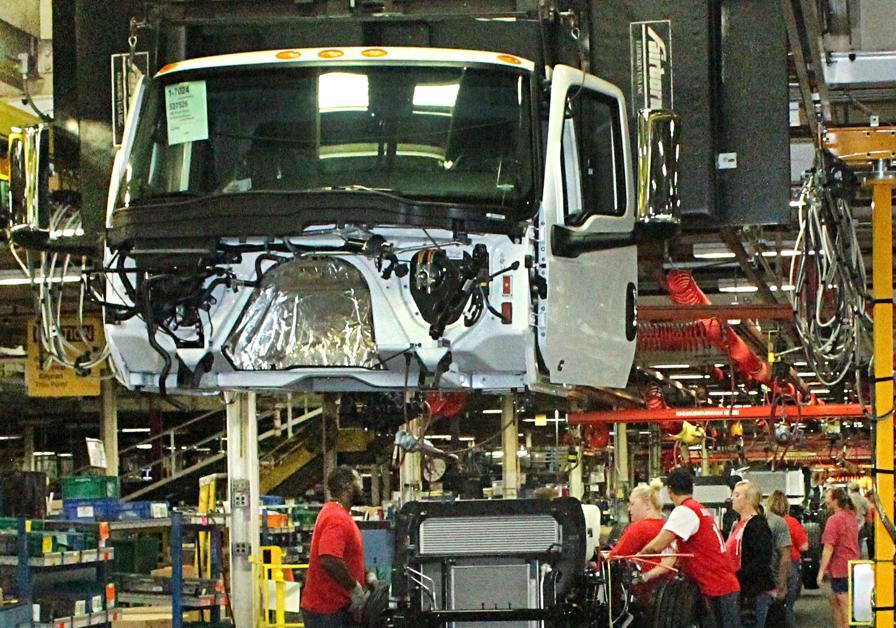
kscarbel2
Moderator-
Posts
18,882 -
Joined
-
Days Won
114
Content Type
Profiles
Forums
Gallery
Events
Blogs
BMT Wiki
Collections
Store
Everything posted by kscarbel2
-
Ford Trucks International Press Release / October 29, 2019 This major launch means that the new big Ford Trucks F-MAX is now in the UAE! #FordTrucks #SharingTheLoad #UAE #Dubai #FMAX #IToY .
-
Ford to reveal Bronco in spring 2020; updated logo unveiled Michael Martinez, Automotive News / November 1, 2019 DETROIT — It's been 1,028 days since Ford Motor Co. announced the return of the Bronco SUV. More than two and a half years later, the vehicle finally has a logo — and a release date, albeit a vague one. Ford on Friday said that the long-awaited off-roader will debut in spring 2020. The company gave no other details, but the vehicle isn't expected to go on sale until late 2020 as a 2021 model-year vehicle. It's likely the automaker could reveal the Bronco around the time of the 2020 Detroit auto show, scheduled for early June. The press dates are technically in the spring; summer starts June 20th. Ford on Friday also revealed an updated bucking horse logo and wordmark in a teaser video that showed the Bronco's evolution through the years. The logo and wordmark are slightly different from what Ford showed when it confirmed plans for the Bronco at the 2017 Detroit auto show. The automaker plans to build both two- and four-door versions of the Bronco. It's designed to be customizable, with a removable hard top and removable doors that can be stored in the vehicle's cargo area, according to those who have seen it. The side mirrors will be attached to the front pillars so they remain in place when the doors are taken off, unlike the Jeep Wrangler — one of the chief rivals Ford is targeting with its Bronco revival. Ford also is planning a Bronco-based pickup, according to forecasting firm AutoForecast Solutions, as well as a smaller off-roader and a small, unibody pickup to be part of an off-road family of vehicles. The Bronco will be built at Ford's Michigan Assembly Plant, alongside the Ranger. .
-
It's amazing that Workhorse is still in business, and I'm confident they won't be for much longer. Ford doesn't produce medium trucks (F-650/F-750) at a meaningful profit. It's purely for face. Yes, I'm thrilled that Ford is still at least in medium, however I can easily imagine Blue Oval having a change of heart and departing the segment to focus on other.
-
Ram, Dodge and Chrysler set to come under Chinese ownership
kscarbel2 replied to kscarbel2's topic in Trucking News
I have to, respectfully, disagree with that. Fiat has little proprietary "tech", but rather only the tech of its suppliers that it pays for the use of. -
Bob, sounds like Ford is repurposing Avon Lake for electric car production (the electric F-150 won’t be built there). https://www.autonews.com/manufacturing/ford-changes-plans-again-underused-mustang-plant-report-says
-
Ram, Dodge and Chrysler set to come under Chinese ownership
kscarbel2 replied to kscarbel2's topic in Trucking News
Jeep and Dodge Trucks (aka. Ram) are the money makers depended on. And yet quality issues are everywhere due to excessive cost cutting. https://www.google.com/amp/s/www.caranddriver.com/news/amp29144073/nhtsa-jeep-wrangler-steering-shimmy-complaints/ -
Commercial Carrier Journal (CCJ) / October 31, 2019 Nine trucking companies are currently participating in the Federal Motor Carrier Safety Administration’s Under-21 Military CDL Pilot Program that allows 18-20-year-olds with the military equivalent to a CDL to drive across state lines. A new FMCSA website lists the carriers that are participating in the program and gives contact information for each so that military members can find and apply for interstate trucking jobs. Participating carriers include UPS Freight, Prime Inc., Werner Enterprises, Total Transportation of Mississippi, PI&I Motor Express, May Trucking, Lily Transportation, Gully Transportation and Golub Corporation. Trucking companies can still apply to participate in the pilot program here. The Under-21 Military CDL Pilot Program is slated to run for up to three years. During the program, the safety records of participating drivers will be compared to the records of a control group of drivers ages 21-24 with CDLs and comparable training and experience driving trucks to determine if age is a critical safety factor. DOT will use the information to present recommendations to Congress on whether the interstate driving age should be lowered or not in the future. FMCSA is also considering expanding the pilot program to allow non-military-trained drivers under the age of 21 to participate. A comment period was open during the summer, but no further action has been taken yet.
-
Volvo adds regional sleeper cab to its truck offerings Josh Fisher, Fleet Owner / October 29, 2019 ATLANTA — Volvo Trucks North America (VTNA) is rolling out a new truck model aimed at regional-haul and driver comfort. The new Volvo VNR 660 truck will be available for order in the first quarter of 2020, the OEM announced at the North American Commercial Vehicle (NACV) Show on Oct. 28. As fleets adjust their operations to accommodate regulations such as federal or state bridge laws, length laws or weight limitations, VTNA says the VNR 660 will offer customers a way to increase payload capacity while still satisfying certain length and weight requirements. It also features a sleeper cab, a rare feature for truck models designed for regional haul. “The new VNR 660 truck model addresses the needs of regional-haul customers looking for ways to increase payloads by decreasing the weight of the vehicle and enabling the use of longer trailer sizes without sacrificing efficiency,” said Chris Stadler, product marketing manager at Volvo Trucks North America. “This new model also offers the comfort and extra space of a high-roof sleeper, increasing driver comfort.” The new model features a shorter, 164-in. bumper to back-of-cab length that offers both weight savings from decreasing the overall size of the truck and the option to use more versatile tractor-trailer combinations for increased cargo capacity. As an extension of the Volvo VNR product line, the new Volvo VNR 660 combines a high-roof configuration with a 61-in. sleeper that will comfortably accommodate an extra person for an overnight stop, making it ideal for local and regional routes that utilize team drivers. There is room for a refrigerator, microwave, and television with storage above the driver and passenger seats. The new VNR 660 is available with the Volvo Premier Trim package, which includes wood-grain trim for the dash and cabinetry. Other advantages of the new Volvo VNR 660 include the shorter hood design of the VNR product line, providing optimized visibility for the driver and excellent maneuverability in urban areas and easy docking in tight spaces. The new truck model comes standard with the Volvo D11 engine, the Volvo I-Shift transmission, and Volvo Active Driver Assist (VADA) 2.0, the recently updated comprehensive collision mitigation system. FlowBelow Volvo Trucks also announced at NACV that it will offer the FlowBelow Tractor AeroKit, which includes a system of wheel covers and fairings designed for improved aerodynamics and fuel efficiency, as a factory-installed option in Q2 2020. “The aerodynamics of our trucks have a significant impact on fuel efficiency and our customers’ bottom line,” said Allison Athey, product marketing manager, Volvo Trucks North America. “The new FlowBelow package offers our customers an enhanced aerodynamic option, providing up to an additional 1% increase in fuel efficiency when combined with our most aerodynamic truck spec, including the Xceed fuel efficiency package, and a dry van with trailer skirts, further reducing environmental footprints.” The FlowBelow Tractor AeroKit is a complete system designed to minimize turbulence and improve aerodynamics by surrounding the drive wheels to better manage the air that moves around the tractor while in motion. The system consists of wheel covers, a center fairing between the wheels, and a rear fairing behind the wheels. These pieces work together to maintain control of the airflow from end to end, keeping the air running along the side of the truck and around the wheels. The air is then funneled out when it reaches the back of the truck, jumping the gap between truck and trailer. Volvo Trucks will begin offering factory-installed FlowBelow wheel covers and fairings separately, as well as the full FlowBelow Tractor AeroKit included with its Xceed fuel efficiency package as a customer option for truck orders in 4x2, 6x2, and 6x4 axle configurations by the end of 2019. Volvo Trucks will offer factory installation of the FlowBelow system for all VNL and VNR models in Q2 2020. Electric reality VTNA President Peter Voorhoeve said that the truckmaker’s first five Class 8 battery-electric trucks, the VNR Electric, are on the way to California. The trucks are going to select California customers this year as part of Volvo’s LIGHTS (Low Impact Green Heavy Transport Solutions) program. After extensive testing in California, offerings will expand to other regions with customers that have expressed heavy interest in the regional electric tractor, such as New York and New Jersey. At the end of 2020, VTNA will start limited production of the VNR Electric with a straight truck and a tractor. Three axle configurations will be available: 4x2, 6x2 liftable and 6x4. The GVW limit will be 66,000 lbs. By the end of 2021, the OEM plans to introduce an enhanced electric driveline version of the vehicle and next-generation batteries “with more density, more power, more range,” Pope said, adding that the VNR Electric will be available as an 80,000 lb. GCW (gross combined weight) tractor. .
-
Peterbilt gains as more fleets look to reduce average age of fleet
kscarbel2 replied to kscarbel2's topic in Trucking News
Peterbilt is blowing away Volvo and Mack in market share. -
Fleet Owner / October 31, 2019 ATLANTA — Peterbilt Motors Co. continues to strengthen its market position amid signs that more fleet customers are working to lower the average age of their fleets. During a press conference at the North American Commercial Vehicle (NACV) Show, General Manager Jason Skoog outlined new safety and efficiency updates for many of Peterbilt's diesel models and provided an update on its battery-electric lineup. Skoog, who is also a Paccar vice president, expects Peterbilt to end the year with a Class 8 market share approaching 15%. Industrywide sales in the United States and Canada are projected to finish between 310,000 and 320,000 units. With 2020 appearing to be shaping up “as a solid replacement volume year,” sales will fall to between 230,000 and 260,000 units, said Skoog. Peterbilt’s market share in the medium-duty sector hit 9% last year, and Skoog projected it could reach 12% before too long. Skoog said feedback from customers earlier this month indicated that more and more are aiming to keep their average fleet age at less than two years, which translates into a trade cycle of four years or less. In an interview after the press conference, he said that customers believe there are multiple advantages to having a fresher fleet, including that it gives potential driver hires a much "different outlook on first impression.” Beyond recruiting and retention, there are greater fuel efficiency gains and safety technologies with each passing model year, he added. Skoog was pleased to report Peterbilt has taken 11,000 orders for the 579 UltraLoft sleeper model since being launched in the summer of 2018. About 70% of these are from customers who had previously opted for Peterbilt's traditional sleeper, while the others are ones “Peterbilt has never sold trucks to before.” In another announcement at NACV, Peterbilt said the Model 579 will come standard with the next generation Bendix Wingman Fusion safety system starting early in 2020. The updated offering incorporates highway departure braking and multi-lane emergency braking to the existing Bendix system. On the battery-electric truck front, Skoog said Peterbilt will begin distributing pricing and ordering information for its three models in the second quarter of 2020. There are 16 electric Peterbilts already in operation, with 21 more expected to be put into service during the first half of next year. The Model 579EV, 220EV and 520EV were all on display at Peterbilt’s booth in the exhibit hall. Limited production of these vehicles will begin before next year concludes, Skoog said. As extensive testing of electric trucks continue, he stressed that regardless of powertrain, if there is “a Peterbilt badge on the truck, it needs to perform like a Peterbilt.” In other announcements at NACV: Paccar’s 12-speed automated transmission is available for use in vocational applications where the truck spends most of its time on pavement or maintained dirt and gravel roads. The transmission will be available with the Paccar MX-11 or MX-13 engine with up to 510 hp. and 1,850 lbs.-ft. of torque. “The Paccar transmission represents a step change in drivability and performance over previous automated manual transmissions,” said Peterbilt Chief Engineer Scott Newhouse. Peterbilt will begin to offer over-the-air updates for the Paccar MX engines and aftertreatment systems beginning in December for customers with model year 2017 or newer MX-11 or MX-13 engines and an active SmartLINQ subscription. The company also introduced a new Platinum Service Center program that scores each dealership location based on key measures. Dealers who make the grade will be recognized at the annual Peterbilt Dealer Meeting in February. .
-
Navistar showcases truck with EV ecosystem John Hitch, Fleet Owner / October 31, 2019 ATLANTA — Navistar unveiled a medium-duty electric truck at the 2019 North American Commercial Vehicle (NACV) show, and announced the formation of a new business unit to support electrification. The eMV Series, a first for the International brand, debuted at NACV. It is the latest step in Navistar’s push into electrification, a point made clear especially after Andreas Renschler, CEO of Traton Group (which holds a 17% share of Navistar), said that one in three buses and trucks will be electric by 2035. To support that projected growth, the Illinois-based OEM has formed NEXT eMobility Solutions. Based out of Detroit, NEXT comprises a team of engineers well-versed in lean manufacturing techniques and the needs of the customer to construct the optimal trucks or buses for their fleet. For now, NEXT is focusing on the eMV Series, currently a concept and slated for sale in 2021, said CEO Troy Clarke. The eMV Series will feature: 474 kW peak power (645 hp.) 300 kW continuous power (402 hp.) 2,100 Nm of peak torque (2,102 lbs.-ft.) 2,100 Nm continuous torque Three battery capacity options: 107 kWh, 214 kWh and 321 kWh Using the biggest 321-kWh battery for basic pickup-and-delivery jobs, Navistar projects the eMV Series can operate for 250 miles on one charge. The new look truck also has a sleek aerodynamic hood and larger windshield. The IC Bus brand’s electric offering, the chargE, which has been tested in California since March 2018, will be available by the end of 2020. The chargE has a range of more than 120 miles and reaches 260 kW (349 peak hp.). Simply providing the hardware will not be enough, Navistar COO Persio Lisboa acknowledged. Working through the complex path to electrification can be difficult, and more than anything, he said NEXT’s mission is to illuminate the journey and “make the move to electric as easy as possible.” "Companies interested in operating electric trucks have more questions than answers; they are looking for a partner who also brings clarity," Lisboa said. "NEXT combines the technical expertise required to develop leading electric vehicles with the industry experience to deliver custom solutions that go beyond the vehicle." This starts with consulting with each customer, then leveraging Navistar’s experience and the Traton alliance network to build trucks form-fitting to individual fleets’ needs with the latest in EV manufacturing technology. NEXT will also assist with power infrastructure to keep the vehicles charged and connectivity to ensure they stay on the road. “Early adopters are finding there is no one-size-fits-all approach,” Lisboa said. Customizing each customer solution from design to driver is a major tenet set forth by Clarke. Prior to the announcement, Clarke said “next-generation leading technologies” are made possible by “cost-effective access” the partnership with globally scaled Traton provides. Gary Horvat, Navistar's vice president of eMobility, will run the NEXT unit. He previously developed electric bus technology for Proterra Inc., which set a record of 1,100 miles on a single charge in 2017. Also at NACV, the company launched “International 360,” a communications system aimed at streamlining maintenance and repairs. International 360 can support any truck and integrates with several dozen telematics providers through the OnCommand Connection remote diagnostics system. Friedrich Baumann, president of aftersales, said International 360 brings multiple data feeds into one centralized interface. .
-
Ram, Dodge and Chrysler set to come under Chinese ownership
kscarbel2 replied to kscarbel2's topic in Trucking News
Dongfeng (ie. the Chinese government), the French government and the Peugeot family each own 12.2 percent of PSA Group. And recall, the Chinese government is Volvo Group’s largest shareholder. -
A merger between Fiat Chrysler Automobiles (FCA) and France’s PSA Group (Peugeott/Citroen/Opel) now seems highly likely. Chinese government-owned and Chinese Communist Party (CCP) led Dongfeng, which now is Volvo Group’s largest shareholder, is also a principal stakeholder in PSA Group. Thus, Ram, Dodge and Chrysler will come under Chinese control.
-
Hino launches new COE, conventional trucks to medium-duty lineup
kscarbel2 replied to kscarbel2's topic in Trucking News
-
Mack Trucks at North American Commercial Truck Show (NACV)
kscarbel2 posted a topic in Trucking News
. -
Peterbilt Motors Press Release / August 26, 2019 Class Pays Stories: Lattimore Materials' Andy Eisenzimer discusses the Model 567 9 axle truck. .
-
Peterbilt Motors Press Release / October 9, 2019 Peterbilt leads the industry in alternative powertrain offerings with the availability of the Model 579EV, an all-electric Class 8 vehicle. The 579EV joins Peterbilt’s Model 220EV and Model 520EV for the most complete lineup of electric vehicles. .
-
Peterbilt Motors Press Release / October 9, 2019 At PACCAR, Engines are more than a tool to move your trucks forward — they’re the beating heart. Every PACCAR Engine is meticulously designed for maximum power, performance, and efficiency. The PACCAR MX Engine boasts a B10 design life of one million miles in linehaul applications. This means 90 percent of PACCAR MX Engines will log up to one million miles without a major overhaul, almost double the life of comparable engines. The PACCAR MX Engine’s B10 design life stands as the pinnacle of our promise to you – a lifetime of unparalleled durability and quality. .
-
Peterbilt Motors Press Release / August 19, 2019 .
-
Kenworth Trucks Press Release / September 13, 2019 C & A Seneca Construction roll through the streets of New York City in their Kenworth T880. .
-
Cummins Press Release / October 10, 2019 Cummins employees at the Columbus MidRange Engine Plant recently celebrated a major milestone: The 3 millionth engine produced for the legendary RAM truck. Cummins-powered RAM trucks have the DNA of superior technology coupled with decades of dedicated service from the Cummins employees who help build them. All the employees at CMEP have powered the success of the partnership between Cummins and RAM, which has resulted in engines that break records and set new standards in the pickup industry. .
-
Cummins unveils hydrogen fuel cell truck as tech demonstrator
kscarbel2 replied to kscarbel2's topic in Trucking News
-
Springfield News-Sun / October 29, 2019 Navistar is scheduled to resume production on both of its assembly lines in Springfield on Monday after shutting them down last month due to a parts shortage caused by a national strike against General Motors. Chris Blizard, the president of UAW Local 402, said representatives of Navistar expect to start receiving parts this week following the end of the 6-week GM strike called by the United Auto Workers union. The move to shutdown both those lines affected about 1,400 assembly production workers, said Blizard. He said impacted employees will return to work next week if everything goes according to plan. Navistar builds medium-duty commercial trucks, including those for GM, on its main line and GM cutaway vans on its line two. Blizard also estimates that about 300 workers, mainly from the Springfield plant’s paint department and cab line, who have been temporarily laid off as a result of the parts shortage, will return to work this week. Those workers will prepare the lines this week so production can resume on Monday. .
BigMackTrucks.com
BigMackTrucks.com is a support forum for antique, classic and modern Mack Trucks! The forum is owned and maintained by Watt's Truck Center, Inc. an independent, full service Mack dealer. The forums are not affiliated with Mack Trucks, Inc.
Our Vendors and Advertisers
Thank you for your support!


